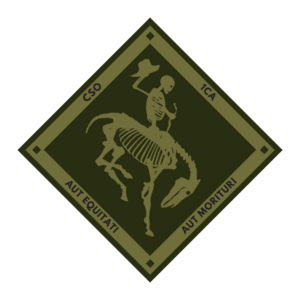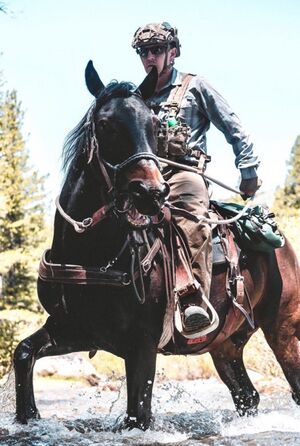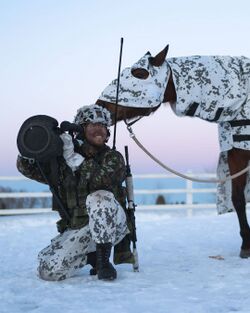1st Light Cavalry Regiment
This article is incomplete because it is pending further input from participants, or it is a work-in-progress by one author. Please comment on this article's talk page to share your input, comments and questions. Note: To contribute to this article, you may need to seek help from the author(s) of this page. |
| 1st Light Cavalry Regiment | |
|---|---|
| 1er Regimiento dei Cavalieri Alares | |
 Cavalieri Alares insignia, displaying the regimental mascots | |
| Active | 1 June 1801 – present (223 years, 11 months) |
| Country | |
| Branch | Exersito Iverica |
| Type | Special operations force |
| Role | Counterinsurgency Counterterrorism Mounted Reconnaissance Unconventional Warfare Search and rescue Training |
| Part of | Special Operations Command Army Special Warfare Division |
| Garrison/HQ | Forta Santa Eila, Vasqqa D'Oeste |
| Nickname(s) | "The Pale Riders", "Vaqueros", "The Marshals" |
| Motto(s) | Aut Equitati, Aut Morituri (Aroman Latin) Ride or Die (Anglish) |
| Mascot(s) | Old Break-Bones and Ornery Mare-Row |
| Engagements |
|
| Commanders | |
| Current commander | Cor. Jose Rodrigo dei Vivar-Jinete |
The 1er Regimiento dei Cavalieri Alares (Anglish: 1st Light Cavalry Regiment), more popularly known as Cav Alares is the Republic of Iverica's horse mounted special forces unit. The regiment was primarily used as a Counterinsurgency unit during the 19th and 20th centuries and were distinguished during both Vasqqan Civil Wars. At present, the regiment is primarily used to supplement other CSO/SOC units like the SOAR Brigade in operations where the terrain is too difficult for light vehicles and when extensive aerial support is not available or outside of operational parameters. The unit has a secondary role of training horses, breeding them, and training officers of the Iverican Army Horse Grenadier Divisions to ride for parade or formal events. The Cav Alares is part of the Republican Armed Service—Special Operations Command (SOC) or Comande Specialé Operaciónes (Iverican), a separate entity under the direct command of the Júnt-Capos or Joint-Leaders of the Armed Service. The regiment is part of the Exersito component of the SOC.
The Cav Alares in its warfighting role is proficient in horsemanship and working alongside their mounts in combat situations in mountainous and extremely inhospitable terrain. Cav Alares personnel are especially trained to conduct long-range reconnaissance actions in hostile territory. Mounts are trained from colthood to be accustomed to Air assault and parachute insertions. The mounts are also conditioned to remain silent and calm in the presence of gunfire and battlefield stimulus. The unit primarily conducted Reconnaissance, surveillance, and target acquisition missions during both Vasqqan Civil Wars and completed several Search and rescue missions within Iverican borders and abroad during peacetime.
Secondarily, the Cav Alares trains some Exersito units' officers in horsemanship and equestrian activities. Officers of the Horse Grenadier units are required to attain a basic proficiency in horseback riding and participating in parades on horse. The Exersito, or Iverican Army, also uses the husbandry or studding and training of horses as a means of raising funds to supplement its budget for personnel and service animal benefits.
The 1st Light Cavalry Regiment consists of an estimated 1,000 servicemen and women organised into a single-battalion regiment. The companies of the regiment are modular to suit the regiments primary mode of operation, supporting larger units as attached special operations forces. The regiment maintains a large quantity of Load-Bearing Combat Goats of the Argic Valley Bull genus, a type of pack goat bred specifically to support horse-mounted units.
History
Founding
In 1798, Raqqan outlaw bands used weapons likely plundered from Guardia Civil posts abandoned during the Iverican Civil War to attack foritified ranching communities around the Vassqa D'Centrale municipalities. On the 14th of October 1799, Raqqan bands led by Albein Tsousuhn executed a raid on Forta dei Sant Ignacio, the action resulted in several casks of powder and a light field gun being stolen, alongside the deaths of 12 men of the 34th Vasqqan Creoloes Infantry Regiment. Tsousuhn's bands were well armed with a mix of carbines, long-barreled muskets, and various swords and lances. The Narvics were mounted on hardy Vasqqan Silvan Stallions, thought by Iverican accounts to be wild horses broken-in and trained by the raiders. In response, the commander of the corregimiento, General dei Brigada Luis Monteforta-Olandes, petitioned Corregidor High Command for a regimental charter. The petition was on the 3rd of March 1800, and the General was granted a charter to raise one single-battalion regiment of light cavalry, alongside a requisitions cheque for up to 800,000 Velles or approx. $20,000,000 Adapton Sesterius by 2023 valuations. The funds were to be used for the equiping of the new regiment which was permitted to recruit Creoles and Peninsulares from the Vasqqan Marches. The charter forbade the recruitment of ethnic Vasqqans registered under any non-compact clan.
The regiment was founded on the 1st of June, in the town of Santa Eila dei Vasqqa and was quartered in and around a pueblo on the outskirts of town which would later be engineered into a fort with earthworks and log ramparts. Officers of the Primer Regimiento dei Cavalieri Alares consisted of a few experienced cavalry officers from the Aigüestorés and local Hidalgos who had ranching experience. The troopers consisted largely of ranch hands, wranglers, stable hands, and a few farmers with riding experience. A minority cadre of non-commissioned officers were from local Narvic cavalry veterans who had returned from putting down Soluk raids in the Alharun Indic Marches. In command was Coronel Onso Fonss-Arma, a Vasqqan Creoles Hidalgo who had served with General Monteforta for 4 years and was distinguished by a Silver Lozenge with antler device for Valour at the 1797 Battle of Arroyo Rosa. Early sentiments based on officer and enlisted correspondence has been generalised as largely positive with a strong esprit de corps from the troopers' and officers' local familiarity and deference to the experienced outsiders from the Aigüestorés who impressed their students with equestrian skill and displays marksmanship on horseback.
In October of 1801, Tsousuhn and a band of picked men led a raid on the pueblo. Tsousuhn had learned of the regimental founding, which had not been inconspicuous. Planning a raid to demoralise and harrass the regiment before it could be properly deployed against his men, Tsousuhn crossed 108 kilometers of highland between his region of operations and Santa Eila, bringing explosives plundered from Forta Sant Ignacio. With a force of only 124 men, his scouts observed the town and pueblo in a hasty reconnaissance before executing their raid. The Raqqans waited for dusk, during that time, a thick fog had settled, allowing the raiders to move largely undetected.
The regiment had been focused on training and had not completed fortifications of their pueblo, given the shortage of materials and time.
TBC
Organisation
Training
Horse Training
Alares horses are trained from colthood to become accustomed to gunfire, truck transport, rotor transport, and in some cases, parachute drops. Handlers use positive reinforcement, reward systems, and sensory stimulus to calm horses. Training associations are similar to the Pavlovian method, supplemented by the presence of adult Alares horses who are already trained, to provide colts with an exemplar figure to mimic. Colts that exhibit skitish personalities that do not abate before the horse is 3 years of age are automatically disqualified and are trained in a separate ranch to be sold or studded for the civilian market.
To acclimatise colts to rotorcraft motions and stimulus, the colts are regularly stabled in a structure where a rotor flywheel is run by a generator. They are also placed in specialised netted cradles which sway to mimic the motion of transport by sling-loading. Acclimatisation to gunfire begins with hearing protection for young colts, to protect their developing ears. To ease them into the sound and sensation of a rider firing, the trainer fires a low-calibre rifle rested on a sandbag laid across the colt's back.
Horses are trained for parachute operations slowly. They are first introduced to the air-droppable pen that will later be rigged with parachutes for the drop. The pen is placed on a hydraulic rocking system is used to simulate turbulence. Training on aircraft entails the horse being given blinds. A heavy horse blanket is also laid on them to provide warmth and help with keeping the horse comfortable. The horse's legs are wrapped in padding and the pen walls are rubber-lined to prevent self-injury. The pen walls are designed to be as close to the legs as possible, to ensure that there is less space for a powerful kick.
Personnel Training
Training to be a Alares Trooper takes an average of 2 weeks in selection and 64 weeks in total regimental training. Selection is a physical and mental process that assesses a applicant's fitness and intelligence. Selection also includes a written exam to assess the applicant's knowledge of horses and horsemanship. Passing selection clears the applicant for qualification and training courses as a candidate.
Qualifications include intense physical training and combat training including marksmanship, grappling, and mounted combat training and practical exams. Mental and fieldcraft aspects of the training include mathematics applied towards the geometry and calculus of navigation and reconnaissance. Horsemanship qualification and training requires candidates to start the course with a wild unbroken stallion, usually a young Vasqqan Silvan, usually between 4 and 5 years of age, that they must break-in before their second week. These horses are never geldings and are raised as close to wild as possible with the exception of acclimatisation training to gunfire and transport by truck or rotorcraft. Failing to break the stallion results in immediate disqualification. If successfully broken-in stallion becomes the candidate's constant companion for the next 64 weeks of foreign language and culture training, problem-solving scenarios, mock combat scenarios, bushcraft, and air assault training. The candidate must spend every night with their stallion and is solely responsible with their daily feeding, exercise, and grooming. During the training period, the candidate is expected to bond with their mount and discipline it for firefights and enemy fire. The basics of horse medical care are also taught and veterinary specialists are always available for weekly check-ups on the mounts' wellbeing.
The final 2 weeks of training is a practical exam that requires the candidate and his mount to traverse a 500 kilometers route around the Aigüestorés national park with no assistance and equipped only with a knife, a blanket, an emergency beacon that disqualifies the candidate if used, and a pistol with a single cartridge for euthanising the mount if it is impossible to save. If their mount dies, the candidate is expected to break-in a new wild horse or be disqualified. Until 2001, candidates were disqualified if their horse is lamed or is killed. Completing the route marks the candidate's final qualification exam. The candidate earns a pair of blackened and sand-blasted stainless steel spurs forged at Santa Eila from the spurs, buckles, and bits of previous troopers. The spurs are cast or engraved with the linked chain pattern of Vasqqa and are known as the Alares Shackles or the Cadenas Alares, signifying the binding between the rider and the mounts he will ride to war.



